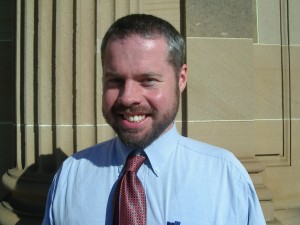 Ben Eggleton
Ben Eggleton
Just as the transistor and microelectronics transformed communications and human society in the 20th century, “light” transistors and microphotonics will revolutionise the way we communicate in the 21st century.
Many of the changes that lie ahead in communications technology are due in part to the work of a young Sydney optical physicist Ben Eggleton, a Federation Fellow and leader of CUDOS, the Centre for Ultrahigh bandwidth Devices for Optical Systems.
For pioneering research in photonics, for his leadership in optical physics – connecting science and industry – and for the invention, and development of optical devices that will change our lives in the decades to come, Professor Benjamin J. Eggleton has been awarded the 2004 Malcolm McIntosh Prize for Physical Scientist of the Year.
Optical fibres carry gigabytes of data across oceans and to our streets, hospitals, schools and businesses. Ben believes that optical devices are going to do much more in the future. The challenge, he says, is to clear the bottlenecks caused by slower electronic circuits.
During his physics PhD, Ben conducted pioneering experiments in non-linear photonics – using one laser beam to control the flow of another laser beam – the light equivalent of a semiconductor or transistor. “Using light to control light is an incredibly fast process that offers the potential to increase communication bandwidth by many orders of magnitude,” he says.
His research was the first step towards a new generation of computing devices using light.
Ben and the CUDOS research team are now working to invent the components of these future devices – such as an optical buffer that can slow down and store light, and photonic wires that transport light in photonic circuits. These devices will be the equivalent of the transistors, capacitors, and other building blocks of electronics.
“Already we have ‘light transistors’ – albeit large ones. Next we have to replicate the microelectronic revolution make everything small, put it together and invent microphotonic computing,” he says.
Ben’s passion for photonics started at 19, during his physics degree at the University of Sydney. An interest in astronomy gave him the chance to work on the optical systems on the Sydney University
Stellar Interferometer telescope at Narrabri. The next step was a PhD and internship at Bell Laboratories in New Jersey – home to several Nobel Laureates and many of the major communications inventions of the 20th century.
His PhD complete, he was invited back to Bell Laboratories by Lucent. Soon he was leading a team of 25 researchers in developing a host of optical devices that were being developed for the communications industry. Just one of his inventions – a “tuneable dispersion compensator” dramatically improved the carrying capacity of long range optical cables – and eliminated a $100 million bottleneck for Lucent.
Brought back to Australia by the lure of a Federation Fellowship and the Australian Research Council funded CUDOS, Ben believes the future for photonics in Australia is bright.
“Australia has a strong optical physics research base, perhaps driven by our interest in astronomy and the southern sky. We are leading the world in a number of areas and have an excellent track record of transforming research into real world applications,” he says.
“I believe we have a unique opportunity to do the fundamental science that will underpin the next communication revolution, capture the social and economic benefit for Australia, and help change the world.”
“But there’s a long way to go in sharing information across the world. The whole of Africa has fewer internet ports than London. I think our technology will help change that.”
Autobiographical Details
* 1970 Born Sydney, NSW
* 1989-1992 University of Sydney, BSc (Hons) in Physics, First Class
* 1993-1996 University of Sydney, PhD in Physics
* 1996-1998 Post-doctorate, Bell Laboratories, Lucent Technologies, US
* 1998-2000 Member of technical staff, Optical Fiber Research Department, Bell Laboratories, Lucent Technologies, US
* 2000-2001 Technical Manager, Optical Fiber Research Department, Bell Laboratories, Lucent Technologies, US
* 2001-2001 Director of Photonic Devices Research, Bell Laboratories, Lucent Technologies, US
* 2001-2002 Research Director, OFS – Specialty Photonics Division, and Director of Photonic Devices Research, OFS Laboratories
* 2003-present Research Director, Centre for Ultrahigh-bandwidth Devices for Optical Systems, an ARC Centre of Excellence; and ARC Federation Fellow and Professor of Physics, University of Sydney
Career Highlights
* 2003 Prize of the International Commission for Optics (ICO)
* 2002 Fellow of the Optical Society of America (OSA)
* 2002 Excellence in Technical Innovation from Laser Focus World Magazine for “Tunable microfluidic optical fiber”
* 2002 R&D100 Award for inventing one of the 100 most technologically significant new products and processes of the year, for the “tuneable dispersion compensator”
* 2002-2003 IEEE/LEOS Distinguished lecturer award for “photonic crystal fiber devices”
* 2001 Federation Fellowship from the Australian Research Council
* 1998 Adolph Lomb medal from the Optical Society of America for noteworthy contributions made before the age of 30 for “nonlinear propagation in photonic bandgap materials”
Research Contributions
100 refereed journal papers, 25 invited presentations at international conferences, six book chapters and one book, 35 filed patents and more than 1,000 citations since 1994.
The first experimental demonstration of nonlinear pulse propagation effects in one-dimensional photonic crystals – including the first demonstration of soliton-effect propagation in Bragg gratings.
The invention and development of photonic devices for signal processing in high-speed communication systems – including dynamically tunable dispersion management devices. Fibre Bragg grating devices, commercialised by Lucent Technologies.
The invention and demonstration of optical devices based on photonic crystal optical fibres.
The invention and demonstration of microfluidic tunable optical fibre.
Seminal publications establishing a theoretical framework for design of optical filters in optical communications systems.
Major advances in fibre grating technology through his fundamental improvements in fabrication technology all the way through to his invention of novel photonic components.

